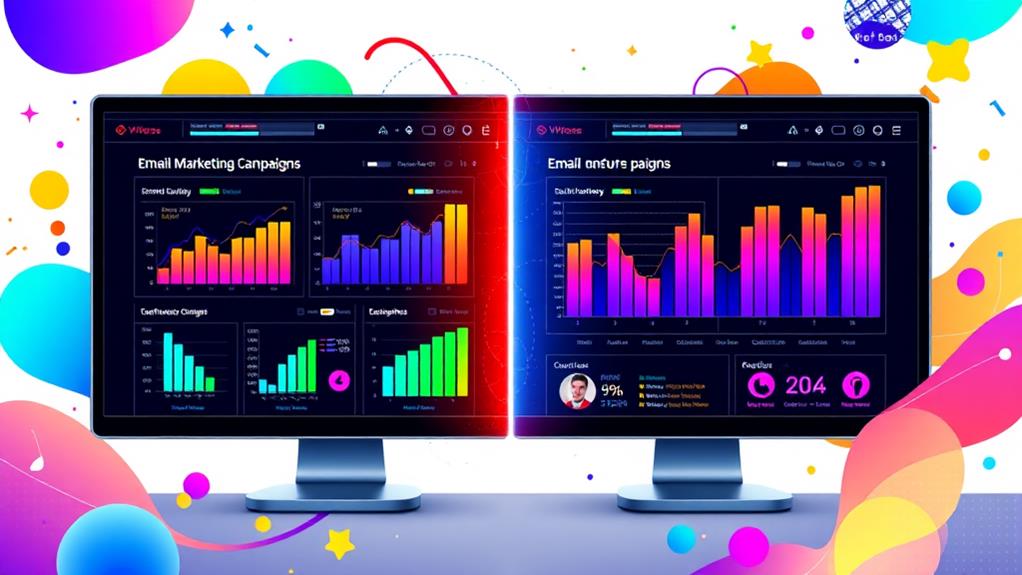To craft the perfect email marketing campaign, begin by defining your target audience; segmentation based on demographics guarantees personalized messaging. Next, set clear, SMART campaign objectives to guide efforts and align team accountability. Design engaging content using strong hooks and personalization to boost open rates by as much as 26%. Optimize for deliverability by maintaining a high-quality email list and guaranteeing mobile-friendly designs. Finally, analyze and refine your results through regular performance monitoring and A/B testing to identify successful strategies. This structured approach lays the groundwork for an effective campaign with further insights yet to uncover.
Key Takeaways
- Define your target audience through demographic analysis and segmentation for precise and personalized messaging.
- Set clear and SMART objectives to align your campaign focus and measure success effectively.
- Design engaging content with strong hooks, personalization, and visual elements to capture and retain reader attention.
- Optimize for deliverability by maintaining a clean email list and ensuring mobile-friendly, error-free designs.
- Analyze and refine results using performance metrics, A/B testing, and audience feedback for continuous improvement.
Define Your Target Audience
Defining your target audience is a cornerstone of any successful email marketing campaign, as it enables marketers to craft content that resonates with recipients' interests, behaviors, and demographics.
By leveraging audience segmentation and demographic analysis, marketers can create personalized messages that engage and convert. Understanding the demographic makeup of your audience—such as age, gender, and location—allows for more precise targeting. This data-driven approach is critical to ensuring that your content aligns with the values and preferences of your audience.
Utilizing databases and market research tools enhances targeting accuracy, helping to identify potential recipients who are predisposed to your offerings. This precision in targeting is achieved through audience segmentation, which involves categorizing your audience based on previous interactions and preferences.
Tailored content, crafted from these insights, greatly boosts click-through rates and engagement metrics.
Furthermore, analyzing behaviors provides insights into your audience's needs and pain points, informing personalized messaging strategies. This strategic focus not only attracts new subscribers but also fosters customer retention and loyalty.
In the competitive landscape of email marketing, such targeted efforts distinguish your campaigns, driving meaningful interactions and achieving substantial ROI.
Set Clear Campaign Objectives
Establishing clear campaign objectives serves as the strategic backbone of any effective email marketing initiative. Objective setting is vital as it aligns your email marketing strategy with desired outcomes, ensuring content relevance and greatly enhancing engagement rates.
By adhering to the SMART criteria—Specific, Measurable, Achievable, Relevant, and Time-bound—marketers can effectively track progress and measure success. This structured approach not only clarifies goals but also maximizes the return on investment, with defined objectives allowing campaigns to achieve an impressive average ROI of $38 for every $1 spent.
When setting objectives, consider tangible targets such as increasing open rates by 20% or boosting click-through rates by 15%. These specific goals drive campaign alignment, offering clear metrics that can be analyzed throughout the campaign lifecycle.
Additionally, well-defined objectives foster accountability among team members, ensuring that everyone is aware of their roles in achieving overall marketing success. By focusing on objective setting, organizations can not only fine-tune their email marketing strategies but also enhance team collaboration and effectiveness, paving the way for successful and profitable campaigns.
Ultimately, clear campaign objectives are essential to the strategic and operational success of email marketing efforts.
Design Engaging Content
When it comes to email marketing, designing engaging content is essential for capturing and retaining the reader's attention. A strong hook, combined with email storytelling and a friendly tone, draws readers in and encourages them to read further. Personalized content, such as including the recipient's name and tailoring messages based on their past interactions, can boost open rates by up to 26%, according to GetResponse. This personalization helps form a connection with the audience, making the email feel bespoke and relevant.
Incorporating visual elements is vital for maintaining interest. Visually appealing HTML designs with graphics can greatly enhance engagement compared to text-only emails. A clean layout paired with clear calls to action (CTAs) effectively guides readers towards goals such as making a purchase or signing up for a webinar. The table below highlights key elements for crafting engaging content:
| Element | Impact | Strategy |
|---|---|---|
| Strong Hook | Captures attention | Start with compelling opening lines |
| Personalization | Increases open rates by up to 26% | Use names, tailor recommendations |
| Visual Elements | Enhances engagement | Utilize graphics, clean layout |
Regular evaluation of email performance using metrics like click-through rates guarantees continuous refinement and optimization of your content strategy.
Optimize for Deliverability
How can you guarantee that your meticulously crafted emails actually reach your audience's inbox? The key lies in optimizing for deliverability by focusing on your email list quality and sender reputation. A high sender reputation score is critical; it guarantees your emails land in the inbox rather than the spam folder.
Maintaining a clean email list is fundamental to this process. Utilize verification tools like Emailable to weed out inactive or incorrect addresses, which not only enhances list quality but also boosts deliverability rates.
Moreover, with over 50% of emails opened on smartphones, optimizing your emails for mobile devices is essential. Mobile-friendly designs improve engagement and guarantee your messages are viewed as intended, contributing positively to your sender reputation.
Additionally, testing your emails for functionality, including links and images, helps prevent issues caused by formatting errors across various email clients.
Consistently reviewing deliverability rates with software tools can identify areas for improvement, guaranteeing high engagement levels. By focusing on these strategies, you bolster your email campaign's effectiveness, guaranteeing your content reaches and resonates with your audience.
Prioritize these deliverability tactics to maximize the impact of your email marketing efforts.
Analyze and Refine Results
Building on the foundation of optimized deliverability, the next step is to guarantee that your email marketing efforts yield the desired outcomes through meticulous analysis and refinement. Regular monitoring of key email performance metrics—such as open rates, click-through rates, and unsubscribe rates—facilitates trend identification and reveals areas needing improvement.
By understanding these trends, marketers can make informed adjustments that enhance campaign efficacy.
A/B testing emerges as a powerful tool in this analysis phase. By testing variations in subject lines, content, and design elements, businesses can derive data-driven insights, allowing for more strategic decision-making in future campaigns.
This process is further enriched by audience segmentation analysis, which uncovers the most engaged groups. Tailoring content to these segments can markedly increase engagement and conversion rates.
Feedback implementation is another vital component. Encouraging subscribers to provide their thoughts on email content offers valuable insights for continuous refinement.
Frequently Asked Questions
How Do You Structure an Email Marketing Campaign?
To structure an email marketing campaign effectively, define clear campaign goals and identify a specific target audience. This approach guarantees relevance, enhancing engagement and retention, as substantiated by marketers prioritizing email strategies for customer retention.
Which of These Are One of the 5 T's of Email Marketing?
Among the 5 T's of email marketing, "Targeting" involves identifying the target audience to enhance engagement, while "Timing" employs strategies for sending emails at ideal moments, thereby improving open rates and maximizing campaign effectiveness through data-driven insights.
How Do I Optimize My Email Campaign?
To optimize your email campaign, implement audience segmentation to deliver personalized content and test various subject lines through A/B testing. This approach enhances engagement and effectiveness, markedly improving open and click-through rates, driving substantial revenue growth.
What Are the 3 Main Steps in Email Marketing?
The three main steps in email marketing include building a targeted email list to reach your target audience, creating engaging content aligned with campaign goals, and analyzing performance metrics to optimize future strategies for improved engagement and effectiveness.
Conclusion
A successful email marketing campaign hinges on a strategic approach that integrates audience targeting, objective clarity, content engagement, deliverability optimization, and result analysis. A data-driven focus guarantees that each element is tailored to enhance effectiveness and achieve desired outcomes. Regular analysis and refinement based on performance metrics are essential for continuous improvement. By adhering to these structured steps, organizations can maximize engagement, improve conversion rates, and ultimately drive business growth through meticulously crafted email marketing initiatives.




